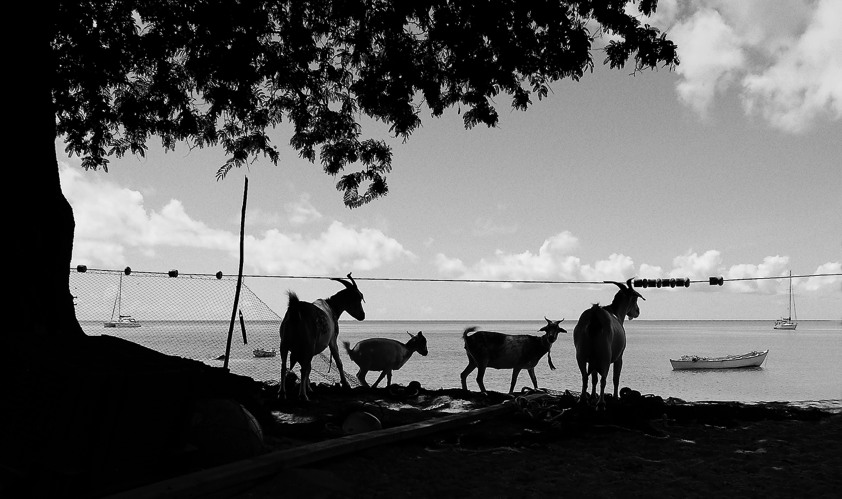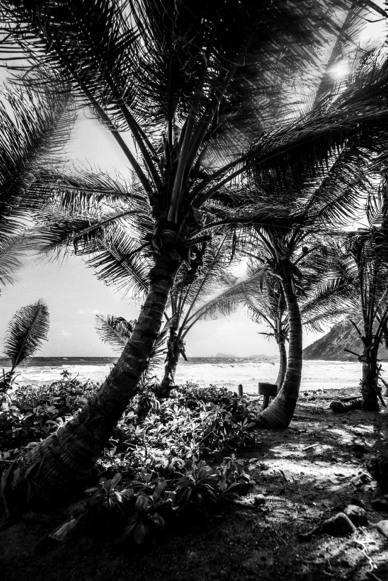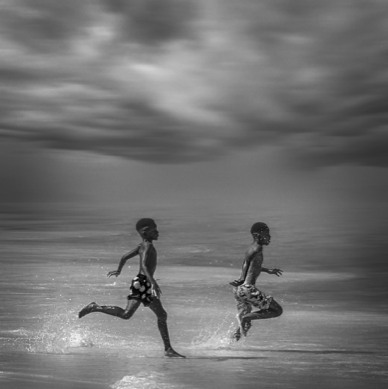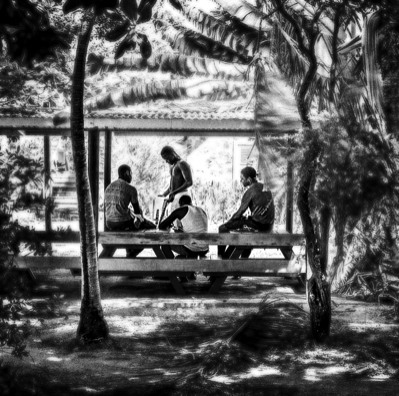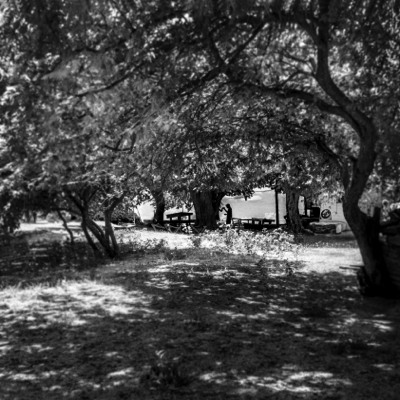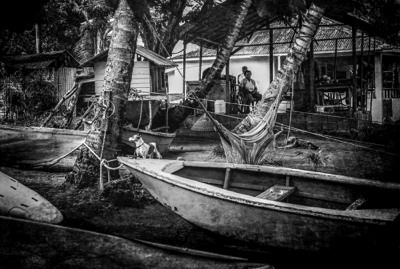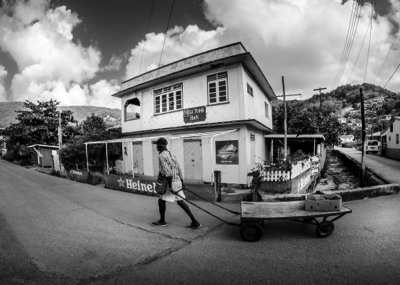The West Indies
in BLACK & WHITE
by David H. Lyman, with photos by Justyna Kramer
This appeared in Compass spring of 2021,
“After a few days of walking around with a camera making photos, people get used to me,” Justyna is telling me. “‘Oh, she’s the one with the camera. She’s okay.’”
Justyna is an amateur photographer, and, for the past ten years, has been the mate on The Dove, Larry Tyler’s 54-foot charter yacht. Recently, due to Covid restrictions, Larry and Justyna elected to stay in the Grenadines for 12 months, moving in a bubble between Admiralty Bay, Bequia, and Chatham Bay on Union Island. With little to do, other than live and work on the boat, Justyna has been working on her photography remotely, taking online tutorials, and going ashore to photograph the people and their habitat.
“Since March 2020, after we dropped off our last charter client, I gave myself an assignment. I said to myself, ‘I will upload a new set of my photos every week.’ That would mean I had to find images in my files, or make new ones, make the conversions to black and white, and upload them to my Facebook and Instagram accounts. So far, I’ve not missed a week and it’s been almost a full year.”
This exercise gave Justyna a goal, a reason to work on her craft and develop her vision. I’ve known Justyna for years. I’ve known Larry for more than 20 years. He and I have sailed together, most recently delivering The Dove from Maine down to the Caribbean in the fall of 2019. That same summer, Larry took The Dove to Greenland while Justyna was my houseguest in Maine. She attended lectures with me at The Workshops, the summer photo and film school I founded in 1973, where she got to meet some of the visiting faculty. I’ve been counseling her ever since, prodding her to get serious about her work. I was gratified last fall to see a new direction in the work she was sharing on Facebook. It was black and white. Gone were the vibrant colors of the Caribbean. Black and white photography has always been a translation of reality into a medium that strips away the emotional response color imparts to a photograph.
I spoke with Justyna via Zoom recently. She and Larry were aboard The Dove, anchored near Ste. Anne on Martinique. I asked her to tell me how she came to realize that black and white might work as a way of seeing the Caribbean.
“I discovered when converting some of my older color photos into black and white they became more dynamic. The personality of the person came through stronger than when seen in color. Color can often get in the way.”
I agreed. The viewer is often responding emotionally to the colors, missing the underlying intent of the image. Take the color away and you see more. Ernst Haas, the father of color photography, would tell his Master Class students, “Be careful. Color can be too much. Black and white photos are a distillation of reality. The photographer allows us to see more directly into the subject, the person.” Black and white photos still have to be well seen, I told her. It’s not a special effect or trick to be used to make a dumb picture look better. (There was a saying going around my school, “If you can’t make it better, make it bigger” — perhaps the large size will impress the viewer.)
I told Justyna the summer she was my houseguest, “Your color images are, for me, well... they are too dark. I’d like to see more what happening in the shadows, just a little.” Justyna is from Poland, and many Eastern European photographers see the world as a dark, foreboding, sinister place. When I saw her new black and white conversions earlier this year, I was excited for her. “I see you found your authentic voice,” I wrote her. “Congratulations!” Her photographs of the Caribbean, the sea and landscape are fresh, full of air, light and contrast.
“Now, when I go ashore to photograph, I go with the intent to see, to work, in black and white,” she tells me. “I still have to make the conversion on my laptop into black and white, but I have mastered the process. I use Photoshop. I have developed a set of adjustments that work for most images, so it’s fairly easy to make the conversions.”
Tell me about the islands, I asked her.
“Each island has its special flavor. The French islands are very large and the people more stand-off-ish. The people on the small islands of Bequia and Union Island, where we spent most of our time this last year, are more friendly. Open. I only have to gesture for permission, and they nod approval. I make a print on a small printer Larry has on the boat and give it to them. They are always pleased and show it around.
“I am still afraid of publishing the portraits I’ve made, as I don’t know how people would feel. They may think I am making money from these photos. Exploiting them. Which, of course, I’m not. I make these images for myself, to see if I can capture their spirit. But I am glad that these few are being published. To have my work recognized is an honor. I hope the people I photographed feel honored as well, for that has been my intent."
Justyna‘s Facebook page and Instagram account are full of her newly seen photographs of the Eastern Caribbean, Maine and Canada, and I hope soon to see more of her original work from Europe, re-seen with her new perspective. Justyna also created an online Adobe portfolio that allows her to upload her photos, creating separate portfolios for each of the themes she’s working on: people, landscapes, places. See https://justynakramer.myportfolio.com. Justina’s Instagram page is JustynaKramerphotography.
JUSTYNA AND HER CAMERA
“I was born in Poland,” Justyna tells me. “Since I was a child I always wanted to travel, live in different countries, meet people and get to know other cultures.” Her camera has helped her do just that.
Self taught, and learning from online courses (she lives on a boat), Justyna has only recently found her voice as a photographer. I asked her what other photographers she followed and she immediately mentioned Helen Levitt, a New York City street photographer who worked in the ’40s and ’50s. Helen’s book In The Street was published in 1987.
Helen, Justyna and many other “street photographers” have been influenced by the work of Henri Cartier-Bresson, a French photojournalist; the Czech photographer Josef Sudak; and Peter Turnley’s contemporary photographs of life on Paris streets. When I asked were there any marine photographers she followed, she responded, “No. I’m not interested in boats. I’m intrigued with people and the way they live. I always have been. It’s why I left Poland 20 years ago. Now I have photography to record of what I’ve seen.”
Justyna has minimal equipment: a Nikon D750, with a fixed 50mm 1.8 lens. Yes, she has a second camera body, a fixed telephoto, and an 85 to 300mm zoom, but the vast majority of her images are made with the normal 50mm lens. This lens sees the world as we do: there’s no distortion of depth as with wide or telephoto lenses. She keeps her gear clean and safe on the boat, and when going ashore, puts the camera in a cooler in the RIB, then takes it out when reaching the dock. “I don’t hide my camera. I want people to know I’m a photographer.”
The use of a normal lens means that Justyna needs to get close to her subjects. This means they have to accept her into their space, to give her permission to be there to photograph them. This is her real talent, the ability to relate to the people she meets. With this ability to get close, to be accepted, what camera and lens she uses is secondary. The camera on an iPhone might do just as well.
David Lyman, a marine journalist, photographer, and author. He founded, and for 35 years, was the director of The Maine Photographic Workshops, an international conservatory for the world’s storytellers and media professionals, now MaineMedia.edu, in Rockport, Maine. A lifelong sailor and boat owner, his stories of the Caribbean appear frequently in Caribbean Compass and other marine publications.
